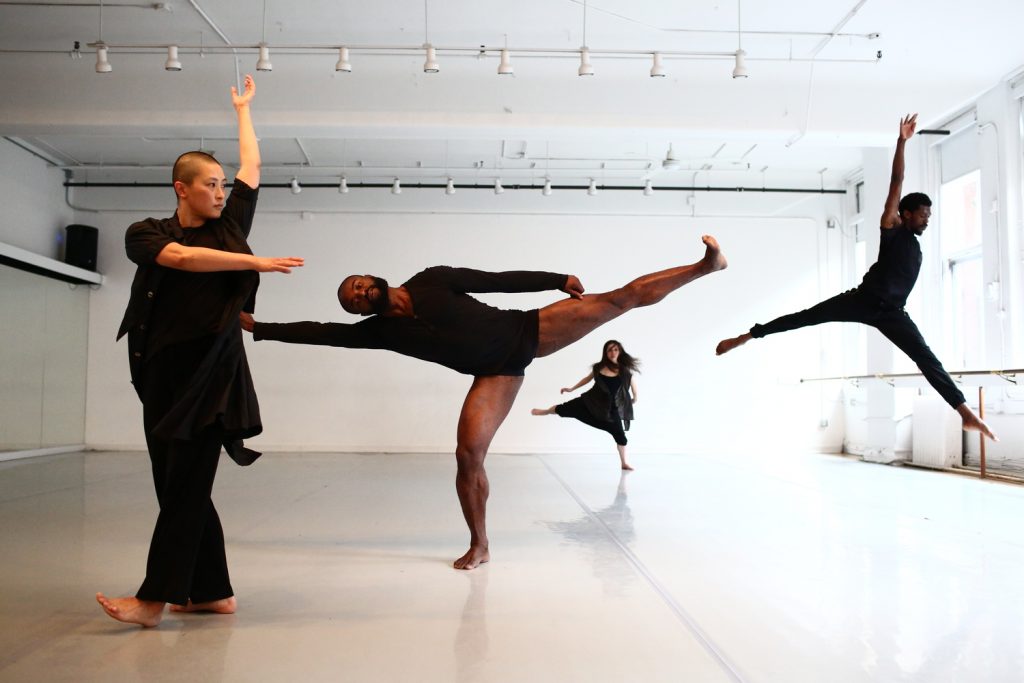
There was a subdued elegance to Citizen, the multimedia work presented May 6 at the Rinker Playhouse in West Palm Beach. It wasn’t at all what I had expected from the Brooklyn-based dance company that calls itself Fist & Heel Performance Group.
The clean and concise structure of the work was reminiscent of the post-modern dance movement of the 1960s and 1970s, when choreographers broke away from the tradition of using dance movement as a vehicle for storytelling and began to experiment with using movement just for movement’s sake. The works were often performed either in silence or to music/sounds that just happened to occur at the same time and place.
Reggie Wilson, the choreographer of the evening-length work and the group’s founder and director, calls his movement style “post-African/Neo-HooDoo modern dance.” Traveling extensively while researching and studying religious and secular activities in Africa, Europe, the Caribbean and the United States, Wilson was driven by his observations to create numerous dance works that examine the African diaspora.
In Citizen, his most recent work, Wilson used several large white panels to frame the stage and to periodically project images that were carefully orchestrated and thoughtfully interactive with the dancer performing on the stage. Most of the time, the image was of the same performer dancing in various outdoor spaces. The use of these visuals was welcome as it added another perspective to the performance, and a riper and more multi-dimensional look to the structure of the choreography.
Citizen was constructed using a series of four solos that were repeated — sometimes overlapping — but had little or nothing to do with each other. Each dancer had his or her own distinct movement vocabulary. Later on, all the solos were executed at the same time. As the dancers passed and traversed the space dancing their familiar movements, they would often cross each other’s paths but always without any acknowledgement of each other’s existence.
The 70-minute work had an almost meditative quality as each dancer would return again and again to move through his or her vocabulary sequence with perhaps just a slight variance in speed or order. Some solos seemed to go on too long, but they all were performed with such strong focus and integrity that I continued to be pulled back (or sometimes lulled back) into the slow, unfolding rhythm of the work.
Some sections were danced in an almost void — in silence and with no projections — with just a dancer performing the constant task of moving through his or her own particular vocabulary. Other times, there were unusual instruments playing that had no real connection to the dancing. There were also times, like at the beginning of the work, where powerful lyrics — “Run, nigger, run, and try to get away” from an 1851 African-American folk song — gave a particular tinge to the movement onstage.
The dancers projected a detached composure, but you sensed a simmering intensity as they meticulously revisited their individual movement vocabulary over and over again. The dancers’ excellent performances were largely responsible for the resulting perception of cohesion and depth to the work. Each seemed to have a strong personal bond to his or her role that never wavered and is now etched in my memory.

In his solo, Yeman Brown distinctively carved his way through the space, often accenting with a high kick of his leg that resonated in a slap as it hit the floor, and he sometimes stopped to squat and look straight out at the audience. Smoothly stringing her movement together, Hadar Ahuvia made her entrance coming downstage with a series of signature flat-back arabesques interspersed with a goddess-like pose of flared arms that framed her face.
Clement Mensah with his strong physicality was almost child-like as he carefully removed his knee socks to engage in hopscotch-like movement that had small brushing gestures added. Ever so slowly, Raja Feather Kelly, with his long and lean stature, began to articulate circular hip and arm movements. Now and then, he stopped to sit on his shins with his arms and gaze raised upward in what became quite a haunting pose.
At times the repeated movement seemed quasi-academic. I kept wondering whether it would all come together with some cohesion. It was only when the four dancers performed their solos at the same time in the same place that a more defined image filtered through. There was a hint of life in tight urban quarters, with people like insects systematically following the daily grind of their routine.
Annie Wang, the fifth dancer of the group, made her appearance towards the end of the work. With her shaved head and solid movement style, she became the catalyst for a unison section that was long awaited but not very impactful, as it was composed of the now overly familiar movement vocabulary of the four dancers’ solos. The ensemble section suggested a feeling of isolation, as if one cannot escape the history of one’s ancestors even if one is functioning as part of a community.
This was a well-presented program, but I had to adjust to its subtlety. I had to go to another place in order to retune my senses to be receptive to the “slow exposure” seen in Wilson’s choreography. I was not surprised that in our world of “entertain me now” that some of the audience was unwilling to go there.
Citizen was a very different experience — definitely not mainstream — but I felt well rewarded for my attention. It is good to see something you hadn’t expected.